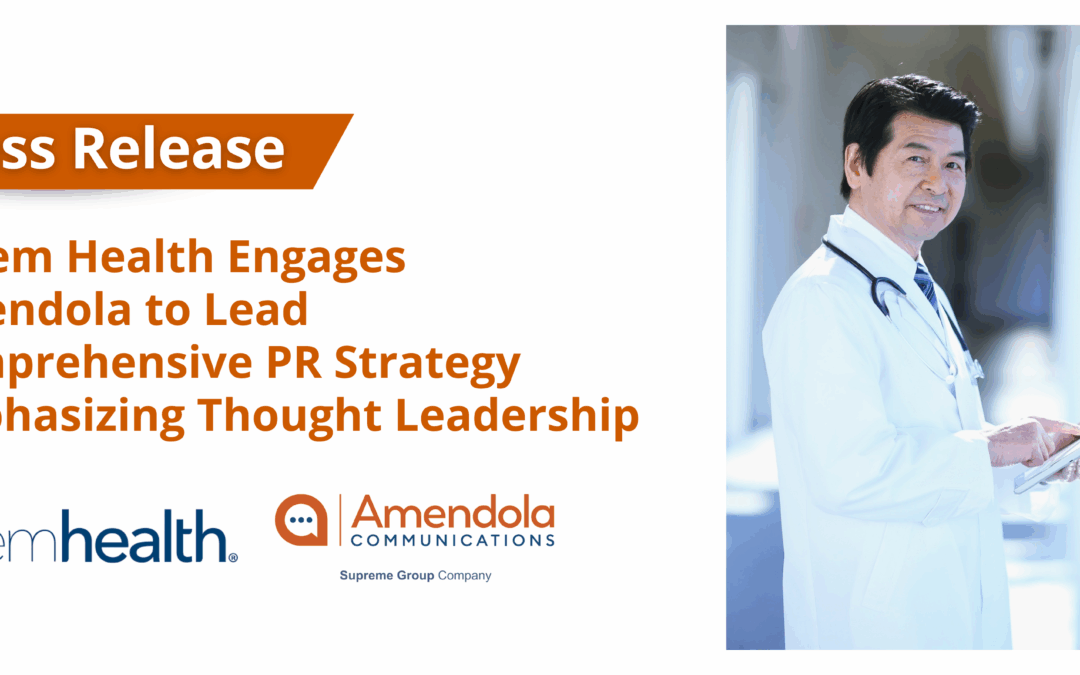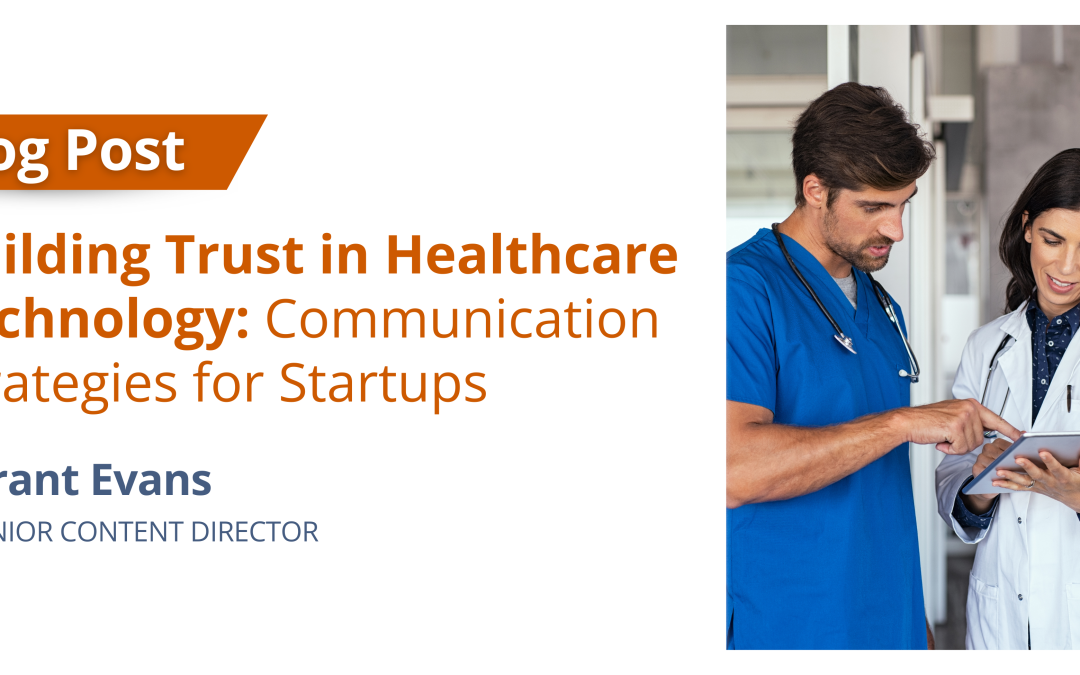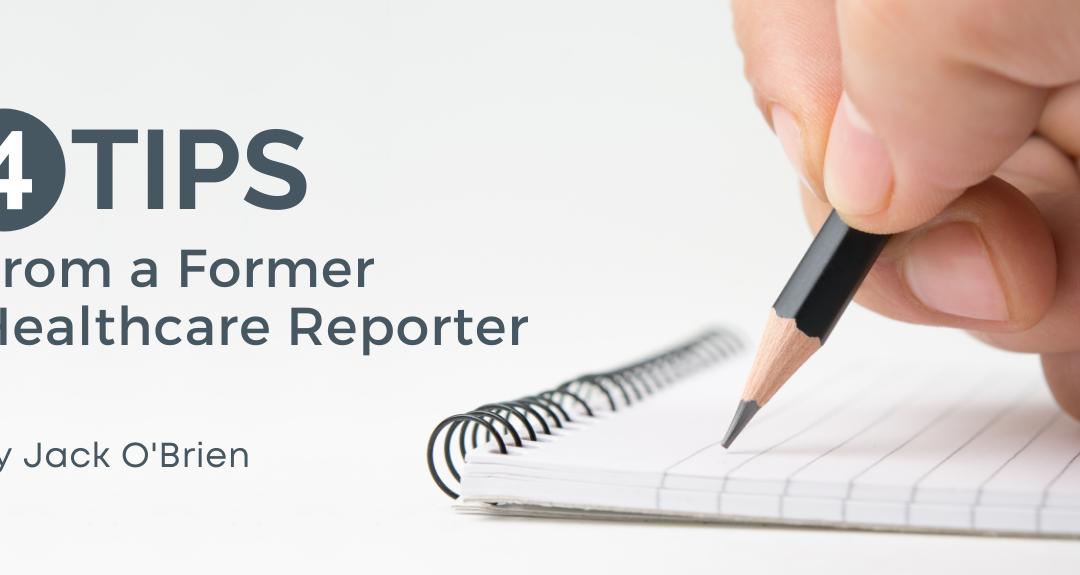
by Michelle Smith | Oct 9, 2025 | News
Initiative to raise awareness of Lucem’s AI-powered disease detection via strategic media relations, social media, and targeted content
SCOTTSDALE, Ariz., Oct. 9, 2025 — Amendola, a nationally recognized, award-winning healthcare technology and life sciences public relations and marketing firm, announced Lucem Health has selected Amendola to execute an integrated PR and marketing program to position the company as a leader in AI-powered early disease detection.
Lucem Health, which was started by Mayo Clinic and is based in Raleigh, N.C., offers a portfolio of AI-driven solutions for identifying undiagnosed patients with certain chronic diseases before symptoms emerge using only their EHR records. It has solutions specifically for arrhythmias, colorectal cancer, liver disease, and type 1 diabetes. Amendola is providing a comprehensive PR and marketing program to showcase these revolutionary screenings, which can be done automatically without patient involvement or disruption of providers’ workflows.
“Too often, providers are forced to react to disease after it has progressed,” said Sean Cassidy, CEO and Co‑Founder of Lucem Health. “By helping caregivers proactively identify patients with undiagnosed disease, we enable earlier engagement, more effective interventions, and better outcomes. We partnered with Amendola to help bring this story to market.”
Agency president Jodi Amendola said: “Leveraging AI to identify people at greater risk of serious disease by using clinically trained algorithms to detect patterns in their medical records is surely one of the marvels of modern healthcare technology. We’re excited to help raise awareness of Lucem Health’s solutions through PR, social media, and marketing programs.”
About Lucem Health
Lucem Health helps healthcare providers accelerate disease detection and treatment using practical, responsible AI—so they can improve patients’ lives and increase the clinical and financial yield from today’s scarce care delivery resources. Learn more at www.lucemhealth.com.
About Amendola
Amendola, part of Supreme Group, is an award-winning, insights-driven public relations and marketing firm that integrates media relations, social media, content, and lead gen programs to move healthcare, life sciences/pharma and healthcare IT decision-makers to action. The agency represents some of the industry’s best-known brands as well as groundbreaking startups disrupting the status quo. Nearly 90% of its client base represents multi-year clients and/or repeat client executives. Amendola’s seasoned team of PR and marketing pros understand the ongoing complexities of the healthcare ecosystem and provide strategic guidance and creative direction to drive positive ROI, boost reputation and increase market share. Making an impact since 2003, Amendola combines traditional and digital media to fuel meaningful and measurable growth. For more information about the industry’s “A-Team,” visit this website and follow us on LinkedIn.
Media Contact: Marcia G. Rhodes / mrhodes@acmarketingpr.com
# # #

by Brandon Glenn | Sep 3, 2025 | Blog
Despite many protestations otherwise, the press release is not dead.
Press releases remain a useful means of sharing key company news, communicating with the broader market, and generating interest among journalists that ideally leads to attention from prospects and customers.
This blog post will offer several key tips for pitching press releases to media, such as including an attention-grabbing subject line, a newsworthy angle that ties in to current industry trends and targeting the right journalists.
Craft an attention-grabbing subject line: The subject line is the first — and often only — chance to capture a journalist’s attention. A compelling subject line should be concise, informative, and engaging without sounding like clickbait. It’s crucial to clearly communicate the value of your news in as few words as possible.
While “Exciting News from XYZ Company” may work as the headline of a social media post, for a subject line that will attract a journalist’s attention, try something more direct like “XYZ Company Launches AI Tool to Improve Hospital Workflow Efficiency.”
Additionally, personalization also goes a long way. Consider referencing a journalist’s recent work or interests in your subject line or introduction to demonstrate relevance and effort.
Lead with a newsworthy angle: Journalists are looking for stories that are timely, relevant, and meaningful to their audience. When crafting a pitch, ask yourself: Why should this news matter right now? Is it part of a broader trend? Does it address a timely issue? For example, tying your announcement to a current event or growing industry concern — such as cybersecurity in healthcare or the rise of health-at-home — can significantly boost the chances of media pickup. A good press release pitch should make the connection between your news and the larger narrative obvious and compelling.
Target the right journalists: Mass emailing a generic press release to hundreds of media contacts is unlikely to yield results and may even harm your reputation. Instead, take the time to identify the right journalists for your story. In general, the best pitches are highly targeted and personalized. Research each journalist’s recent stories, preferred topics, and audience.
This information helps you tailor your message and increases the chances of a positive response. Using tools like media databases and journalist profile platforms can streamline this process, allowing marketers to build curated lists based on beat, outlet, and past coverage.
Make it easy to cover your story: Once you’ve caught journalists’ attention, don’t make them work to understand your news. Provide all essential information clearly and concisely in the body of the email. Include a strong opening paragraph, bullet points with key facts, the full press release, and any relevant visuals or multimedia.
It’s also helpful to offer interview availability with subject matter experts, quotes, or additional background context upfront, so journalists have everything they need to write a story without chasing down more information.
Follow up but don’t spam: Following up after your initial pitch is a standard and sometimes necessary part of media outreach. That said, there’s a fine line between being persistent and being pushy. Wait around 48 hours before sending a polite follow-up email. Keep it short, reiterate the relevance of the news, and offer to provide any additional information.
Avoid sending multiple follow-ups if you don’t hear back. If journalists are interested, they’ll respond. Maintaining professionalism and respecting their time will preserve the relationship for future pitches.
Conclusion
Successfully pitching press releases to media requires more than blasting an announcement to a generic list. By focusing on personalized, timely, and targeted outreach, while also making journalists’ jobs easier, marketers can increase the odds that their news will get the coverage it deserves.

by Grant Evans | Mar 19, 2025 | Blog
In healthcare technology, trust isn’t just a marketing goal—it’s the foundation of success. While established healthcare brands leverage decades of reputation, startups face the unique challenge of building credibility from scratch in a sector where mistakes can have serious consequences.
Leveraging Expertise Strategically
Your team’s credentials and experience are your first trust-building assets. However, many health tech startups underutilize these valuable proof points. Beyond simple bio pages, consider developing thought leadership content that showcases your team’s deep understanding of healthcare challenges and solutions. Regular blog posts, whitepapers, and speaking engagements help position your experts as reliable voices in the field.
Data-Driven Credibility
Original research and survey data are powerful trust-building tools. Consider conducting annual industry surveys that explore healthcare technology trends, challenges, and adoption patterns. This primary research can fuel an integrated content strategy:
- Transform survey insights into comprehensive ebooks and whitepapers
- Create press releases highlighting key findings for media coverage
- Develop social media campaigns featuring data points and infographics
- Gate premium content to capture leads while building authority
- Use data points in media pitches to secure coverage and commentary opportunities
This approach positions your startup as a knowledge leader while generating valuable marketing and PR opportunities. Media particularly value exclusive data, making your startup a go-to source for industry insights.
Establishing Partnerships
Strategic partnerships with established healthcare institutions can significantly accelerate trust-building. Whether it’s pilot programs with hospitals, research collaborations with medical schools, or integration partnerships with established health tech platforms, these relationships signal credibility to your target market.
Many successful health tech startups begin by focusing on a single respected partner, perfecting their solution in a real world environment before expanding. This approach provides valuable case studies and testimonials—essential tools for building broader market trust.
Demonstrating Compliance and Security
In healthcare, compliance isn’t just about checking boxes—it’s about protecting patients. Clear communication about your regulatory compliance status, security measures, and data protection protocols is crucial. Consider creating dedicated security and compliance content hubs that explain complex requirements in accessible terms.
Be transparent about your current stage and future roadmap. If you’re still working toward certain certifications, communicate your progress and commitment to meeting industry standards.
Creating Evidence-Based Content
Healthcare decisions require solid evidence. Develop content that demonstrates both your solution’s effectiveness and your understanding of healthcare’s complexities. This might include:
- Detailed case studies with measurable outcomes
- Research collaborations and clinical validation studies
- Regular analysis of healthcare trends and challenges
- Clear explanations of your technology’s scientific foundation
Building Media Relationships
Focus on building relationships with healthcare technology journalists and influencers before you need coverage. Provide them with genuine insights, exclusive data, and expertise, not just company news. When you do have news to share, these established relationships will help ensure more informed, credible coverage.
Leveraging Agency Expertise
For many health tech startups, partnering with an experienced communications agency can accelerate trust-building efforts. The right agency brings established media relationships, content development expertise, and integrated campaign experience. They can coordinate media and analyst relations while developing compelling content that showcases your expertise.
However, success requires more than just hiring an agency. Designate a dedicated in-house resource to serve as the primary liaison. This person should facilitate content approvals, coordinate subject matter expert interviews, and monitor industry developments that could fuel new content or media opportunities. This partnership approach ensures your agency can execute effectively while maintaining alignment with your company’s goals and expertise.
The Long Game
Trust in healthcare technology isn’t built overnight. A consistent, multi-channel approach focused on expertise, evidence, and transparency will gradually establish your startup as a credible player in the healthcare ecosystem. Remember, in healthcare technology, trust isn’t just about marketing—it’s about demonstrating your commitment to improving patient outcomes and advancing healthcare delivery through validated, data-driven approaches.

by Brandon Glenn | Sep 18, 2024 | Blog
You’ve done the hard work of crafting a public relations strategy, researching the right media targets, and pitching the story to journalists.
Reporters have responded positively to your pitches and are interested in setting up interviews to learn more about your company and executives’ viewpoints. Now what?
For most companies, and in particular startups, media interviews represent a valuable opportunity to introduce their stories, value propositions, and reasons for existence to a broader audience of potential customers, investors, employees, stakeholders, and other industry participants.
However, executives are sometimes hesitant to engage in interviews because they are reluctant to put in the time to mentally prepare or are fearful that reporters will ask them difficult or confusing questions.
The good news for health IT leaders is that there is little to fear. By doing a little homework and preparation prior to a media interview, executives can approach the event with calmness and confidence.
The following are four preparation tips to ensure media interview success:
Turnabout is fair play: Once the interview starts, the reporter will ask many questions of you. Before the interview, take advantage of the opportunity to gain clarity about reporters’ intentions by turning the tables and asking them a few questions. Who is the publication’s audience? What is the reporter interested in talking about? Will she share a list of questions prior to the interview? Do your diligence to make sure the opportunity is worth the time.
Get to know the reporter: Take some time to perform a little pre-interview research about the reporter, browsing through her bio or LinkedIn profile. Read through some of the articles she’s previously written. By getting a feel for the reporter’s background and interests, executives gain fodder for rapport-building pre- and post-interview small talk, demonstrate that they value the reporter’s time and work, and set the stage for follow-up coverage.
Craft talking points: As the one asking the questions, the reporter is generally in control of the interview, but that doesn’t mean that the interview subject is merely along for the ride and must go wherever the reporter steers the conversation. Executives should come prepared with a few basic talking points that expound upon the problems they solve, the negative consequences of those problems for their customers, and why their solution is the right choice to solve these problems. Talking points should be quick, straightforward, and conversational. Repetition of key points is encouraged.
Follow-up and promotion: During interviews, executives often make points or cite statistics that require further clarification or verification by reporters. Be sure to follow up to see if the reporter needs any further information. After the article goes live, promote it through all available channels, including social media, company blog, website, and email to customers and prospects.
Unless your company is an industry giant or a household name, opportunities for media interviews don’t come along that often. When they do, set yourself up for success by investing the necessary time and effort into interview preparation.
For more media interview preparation tips, check out this post from my colleague Philip Anast.

by Jack O'Brien | Oct 13, 2021 | Blog
Career changes are rarely easy, especially when you study a field throughout college and subsequently work in it following graduation.
In August, I left a respected healthcare trade journal after nearly four years and ‘crossed over to the dark side,’ as they say.
There were several professional motivations behind the move, but one that excited me about joining the world of public relations (PR) was that I had already worked with numerous agencies during my time on the editorial side.
As I’ve settled into my new role, I wanted to share four observations on the PR strategies that I found most effective while in my capacity as a journalist.
1. Understand who you’re pitching to
Every PR representative should take time to do their research on the journalists and outlets that they’re pitching.
In my time at the magazine, I primarily covered healthcare finance, policy, and revenue cycle, among a handful of other industry-related topics. Still, I received countless emails from aimless PR representatives pitching me everything from CBD oils to a historian for the band Aerosmith. (Yes, this actually happened.)
Even those that understood I covered the healthcare industry for an audience of payer and provider executives would occasionally float article ideas and interview opportunities that simply missed the mark.
If you’re looking to place a byline or secure earned media with an interview opportunity, make sure you know who you’re speaking with and why it’s worth their while. I always found myself most responsive to PR representatives who weren’t just looking for free publicity but could see down the field about how the interaction would lead to a greater result for both sides.
2. Get to the point (and have other options available)
The only thing worse than getting a random PR pitch that’s off-topic is being forced to read several paragraphs to find out it’s irrelevant.
Short, timely pitches are always winners. The pitch should tell me what the topic is, who can speak to it, and when they’re available.
Additionally, a pitch should offer flexibility for both the PR agency and the outlet. If you’re pitching a potential source as an expert on revenue cycle management but they can also speak to the price transparency regulations and the effects on provider organizations, mention that in your email.
You should be providing as many onramps as possible for a client to appear in a story.
3. Relay expectations to your client
Understandably, most clients probably don’t fully understand how the world of PR and media works. That’s fine, but you have to be the one who explains the dynamics at play so they’re not disappointed by outcomes that don’t match their expectations.
Not every interview is going on the front page of The New York Times, but every speaking engagement, written Q&A, or byline adds up to meaningful coverage.
Additionally, media training to refresh even the most charismatic leaders should be the standard. During interviews I conducted as a journalist, I learned quickly which PR contacts had adequately gone over their notes with my subjects ahead of time and which ones threw them headfirst into the fire.
Don’t leave your clients treading water; let them know what the opportunity is about, why they’re qualified to speak on the subject, and prepare them for any extraneous questions.
4. Create a conversation
Some of the most reliable PR contacts from my journalism days were people who didn’t just pitch me and disappear into the night.
They stuck around and actually engaged with me as normal people do. Whether this was sending the occasional email to see what stories I was working on, interacting with each other on social media, or reading my content, it kept them in my purview as I went about my job.
Additionally, whenever I had a story to write on a tight deadline, I knew I could reach out to these reliable PR contacts and get the appropriate sources on the line.
This doesn’t mean that you have to be chummy with every journalist you come across, (odds are they aren’t always going to chummy in response), but breaking down the at-times acrimonious barrier between church and state can be helpful.
I hope that these tips based on my understanding of how media outlets operate can provide the world of PR with some useful tips to be more effective in the work we do.
Page 1 of 912345...»Last »




